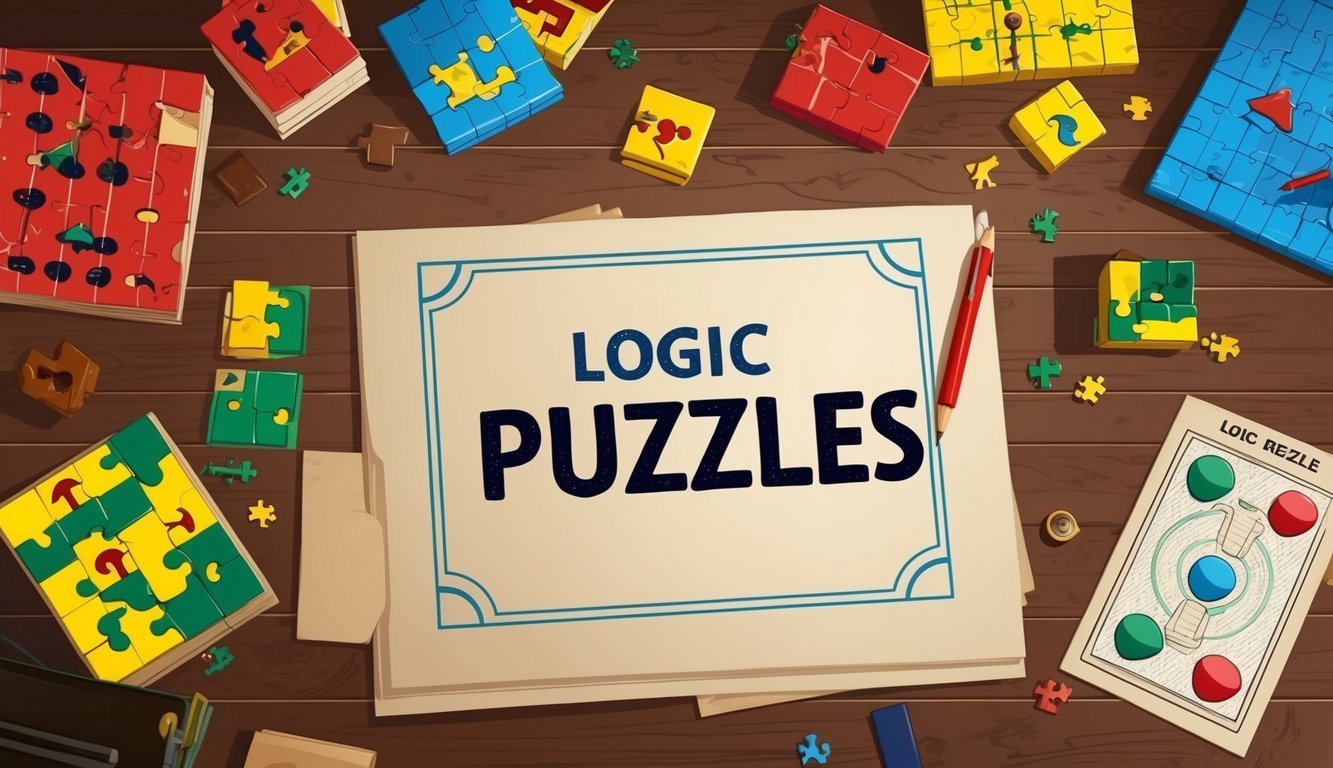Logic puzzles are a fun way to challenge your mind and improve your problem-solving skills.
These brain teasers come in various forms, from grid-based deductions to word problems that require careful reasoning.
You can find thousands of logic puzzles online.
They range from easy to very hard and are suitable for both kids and adults.

Ever wanted to feel like a detective? Logic puzzles give you that chance.
You’ll sift through clues, make connections, and use deductive reasoning to crack the case.
It’s not just about finding the right answer – it’s about the journey of logical thinking that gets you there.
Ready to give your brain a workout? Logic puzzles are available in different formats.
You can solve them online for a quick mental break, print them out for some screen-free entertainment, or even compete with other puzzle enthusiasts.
Whether you’re a beginner or a seasoned pro, there’s always a new challenge waiting for you in the world of logic puzzles.
History of Logic Puzzles
Logic puzzles have captivated minds for centuries, evolving from simple riddles to complex mathematical challenges.
You’ll find their origins rooted in ancient civilizations and their popularity exploding in the 19th century.
Early Beginnings
You might be surprised to learn that logic puzzles trace back to ancient times.
The Greeks and Romans loved riddles and word games that tested reasoning skills.
In medieval Europe, you’d find monks creating intricate word squares and number puzzles to sharpen their minds.
Chess, while not strictly a logic puzzle, emerged as a game of strategy that exercised logical thinking.
You could argue it paved the way for more abstract reasoning challenges.
By the 17th century, mathematicians like Leibniz were developing formal systems of logic.
This laid the groundwork for more complex puzzles to come.
Rise in Popularity
The 19th century saw logic puzzles really take off.
You can thank Lewis Carroll for that! In 1887, he published “The Game of Logic,” introducing formal logic puzzles to the public.
Newspapers began featuring puzzles regularly, giving you brain teasers with your morning coffee.
Jigsaw puzzles also gained traction, offering a different kind of logical challenge.
The 20th century brought even more variety.
You’d find crosswords, Sudoku, and other number puzzles in every newspaper.
Chess tournaments became huge events, showcasing logical thinking as a spectator sport.
Today, you can access countless logic puzzles online or through apps.
They’ve become a popular way to keep your mind sharp and have fun at the same time.
Types of Logic Puzzles
Logic puzzles come in various forms, each challenging your reasoning skills in unique ways.
From classic brainteasers to visual conundrums, these mental exercises offer something for every puzzle enthusiast.
Classic Brainteasers
Classic brainteasers often involve scenarios or riddles that require careful analysis.
You’ll encounter puzzles like the “River Crossing” where you must figure out how to transport items across a river with specific constraints.
Another popular type is the “Knights and Knaves” puzzle, where characters always tell the truth or always lie.
These puzzles test your ability to break down information and draw logical conclusions.
They’re great for sharpening your critical thinking skills and often don’t require any specialized knowledge.
Try solving a few classic brainteasers next time you want a quick mental workout!
Math-Based Challenges
Math-based logic puzzles blend numerical skills with deductive reasoning.
You’ll find favorites like Sudoku, where you fill a 9×9 grid with numbers following specific rules.
KenKen puzzles add arithmetic operations to the mix, challenging you to use basic math skills alongside logic.
Popular Math-Based Puzzles:
- Sudoku
- KenKen
- Kakuro
- Magic Squares
These games improve your numerical fluency and pattern recognition.
Don’t worry if you’re not a math whiz – many of these puzzles rely more on logic than complex calculations.
Word and Language Puzzles
Word puzzles test your vocabulary and language skills while exercising your logical thinking.
Crosswords are a classic example, but logic-based word puzzles go beyond simple definitions.
You might encounter word grids where you deduce the placement of words based on clues.
Cryptograms challenge you to decode a secret message by figuring out letter substitutions.
These puzzles are perfect for boosting your language skills and lateral thinking.
Plus, they’re a fun way to expand your vocabulary!
Visual and Spatial Conundrums
Visual logic puzzles put your spatial reasoning to the test.
Tangrams, where you arrange shapes to form specific outlines, are a prime example.
You’ll also find grid-based picture logic puzzles like Nonograms, where you reveal a hidden image by following numerical clues.
Other challenges include:
- Jigsaw puzzles
- Mazes
- Optical illusions
These puzzles enhance your ability to visualize and manipulate objects mentally.
They’re particularly enjoyable if you’re a visual learner or enjoy hands-on problem-solving.
How to Solve Logic Puzzles
Logic puzzles challenge your deductive reasoning skills.
They require careful analysis of clues and systematic elimination of possibilities to arrive at the correct solution.
Understanding the Rules
Before diving in, familiarize yourself with the puzzle’s structure.
Read the introduction carefully to grasp the context and any specific rules.
Identify the categories involved, such as names, colors, or items.
Note the number of elements in each category.
Pay attention to the grid layout if one is provided.
This will help you visualize relationships between different elements.
Remember, each item in a category can only be matched with one item from another category.
Gathering the Clues
Start by listing all the clues given in the puzzle.
Break down complex statements into simpler ones.
For example, “John is not the oldest, but he’s taller than Mary” can be split into two separate clues.
Use symbols or abbreviations to represent different elements.
This can make it easier to jot down information quickly.
Create a grid or table to organize your findings visually.
Strategy and Techniques
Begin with the most specific clues.
These often provide direct matches or eliminations.
Use the process of elimination to narrow down possibilities.
If you know A isn’t B, and there are only two options, A must be the other option.
Look for connections between clues.
Sometimes combining two seemingly unrelated pieces of information can lead to a breakthrough.
Don’t be afraid to make educated guesses, but always be prepared to backtrack if you hit a contradiction.
Use logical operators like “if…then” statements to draw conclusions.
For instance, if A is true, then B must be false.
Practice regularly to improve your skills and develop your own solving techniques.
Benefits of Solving Puzzles
Engaging with puzzles offers a wealth of advantages for your brain and well-being.
These mental exercises can boost your cognitive abilities, enhance your problem-solving skills, and provide a relaxing escape from daily stresses.
Cognitive Development
Puzzles stimulate your brain, promoting neuroplasticity and enhancing overall cognitive function.
When you tackle logic puzzles regularly, you’re giving your mind a thorough workout.
This mental exercise can improve your memory, attention span, and processing speed.
Solving puzzles also sharpens your focus and concentration.
As you work through complex problems, you train your brain to stay on task for longer periods.
This improved focus can carry over into other areas of your life, boosting productivity at work or school.
Logic puzzles, in particular, strengthen your analytical thinking skills.
They challenge you to break down information, identify patterns, and make connections between different elements.
This type of thinking is crucial for many real-world situations and can enhance your decision-making abilities.
Problem-Solving Skills
Puzzles are excellent tools for developing your problem-solving prowess.
When you approach a puzzle, you’re essentially tackling a challenge with no clear solution at first glance.
This process mirrors many real-life situations you might encounter.
Working on puzzles encourages you to:
- Think creatively
- Consider multiple approaches
- Persist through difficulties
- Learn from mistakes
These skills are invaluable in both personal and professional settings.
The more puzzles you solve, the more adept you become at breaking down complex problems into manageable parts.
Logic puzzles specifically hone your ability to use logical reasoning.
They teach you to approach problems systematically, evaluating different possibilities before reaching a conclusion.
This structured thinking can be applied to various aspects of your life, from financial planning to relationship issues.
Stress Relief and Leisure
Puzzles offer a unique form of relaxation and stress relief.
When you immerse yourself in a puzzle, your mind focuses solely on the task at hand.
This single-minded concentration can create a meditative-like state, helping you temporarily forget about daily worries and pressures.
The act of solving puzzles can lower your blood pressure and heart rate, promoting a sense of calm.
It’s a healthy way to unwind after a long day or take a break from work.
Puzzles also provide a sense of accomplishment when you complete them.
This feeling of success, no matter how small, can boost your mood and self-esteem.
It’s a rewarding leisure activity that combines entertainment with mental stimulation.
For many people, puzzles are a social activity.
Solving puzzles with friends or family can strengthen bonds and create shared experiences.
It’s a fun way to spend time together while exercising your brains.
Logic Puzzles in Pop Culture
Logic puzzles have permeated various aspects of entertainment and popular culture.
You’ll find them in books, movies, games, and online communities, challenging your problem-solving skills in fun and engaging ways.
Literature and Entertainment
You’ve probably encountered logic puzzles in mystery novels or detective shows.
Sherlock Holmes stories often feature deductive reasoning challenges that you can solve alongside the famous detective.
Movies like “The Da Vinci Code” incorporate intricate puzzles into their plots, keeping you on the edge of your seat.
TV game shows like “Brain Games” and “Are You Smarter Than a 5th Grader?” frequently include logic puzzles as part of their challenges.
These shows make puzzle-solving a spectator sport, allowing you to test your skills from the comfort of your couch.
Games and Competitions
Board games and video games often incorporate logic puzzles as core mechanics.
You might remember solving mysteries in Clue or cracking codes in escape room-style video games.
Chess tournaments, while not strictly puzzle-based, require intense logical thinking and strategy.
Puzzle-solving competitions have gained popularity worldwide.
You can participate in events like the World Puzzle Championship or local puzzle hunts.
These contests challenge you to solve a variety of logic puzzles under time pressure, testing your quick thinking and problem-solving abilities.
Online Communities
The internet has created thriving communities for puzzle enthusiasts like you.
Websites and forums dedicated to logic puzzles allow you to share, solve, and discuss brainteasers with fellow fans from around the globe.
Social media platforms have become hotspots for viral logic puzzles.
You’ve likely seen friends sharing tricky math problems or visual puzzles on Facebook or Twitter.
These online challenges often spark lively debates and discussions.
Mobile apps have made logic puzzles more accessible than ever.
You can now carry thousands of puzzles in your pocket, ready to challenge your mind whenever you have a spare moment.
Setting Up Your Puzzle Environment
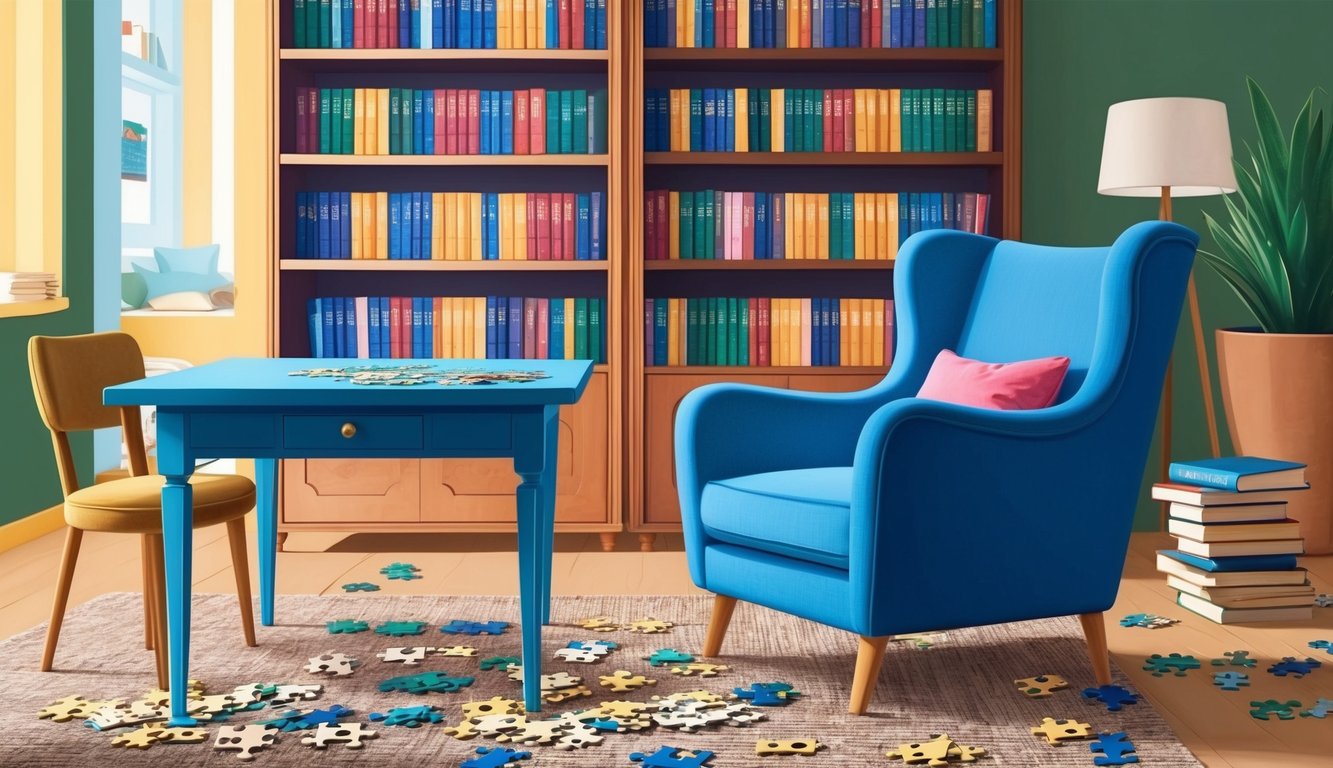
Creating the right environment for solving logic puzzles can enhance your experience and improve your problem-solving skills.
A well-prepared setup allows you to focus and enjoy the challenge.
Choosing Your Puzzles
Start with puzzles that match your skill level.
If you’re new to logic puzzles, pick ones with simple grids and fewer variables.
Look for puzzles featuring three friends or basic scenarios.
As you gain confidence, gradually increase the complexity.
Try different types of logic puzzles to keep things interesting.
Grid-based puzzles are popular, but word problems and numeric puzzles offer variety.
Online platforms and puzzle books are great sources for a wide range of options.
Consider the time you have available when selecting puzzles.
Some can be solved in minutes, while others might take hours.
Pick puzzles that fit your schedule and won’t leave you frustrated if interrupted.
The Right Time and Place
Choose a quiet spot where you can concentrate without distractions.
A comfortable chair and good lighting are essential to prevent eye strain and maintain focus.
Your puzzle-solving area should have enough space for your materials.
Set aside dedicated time for puzzling.
Early mornings or evenings often work well when your mind is fresh.
Avoid solving puzzles when you’re tired or stressed, as it can impact your enjoyment and performance.
Consider creating a puzzle corner in your home.
This designated area can help you get into the right mindset quickly when it’s time to solve.
Materials You’ll Need
Gather the right tools before you start.
For grid-based puzzles, have a pencil with a good eraser handy.
Colored pens or highlighters can help you organize information and track clues.
A notebook or scratch paper is useful for jotting down ideas or working through complex deductions.
Some puzzlers prefer graph paper for creating their own grids or visualizing relationships.
If you’re using puzzle books, a bookmark can help you keep your place.
For online puzzles, ensure your device is charged and you have a stable internet connection if needed.
Consider investing in a small whiteboard and markers.
This reusable surface is great for brainstorming and can save paper in the long run.
Popular Logic Puzzle Variants
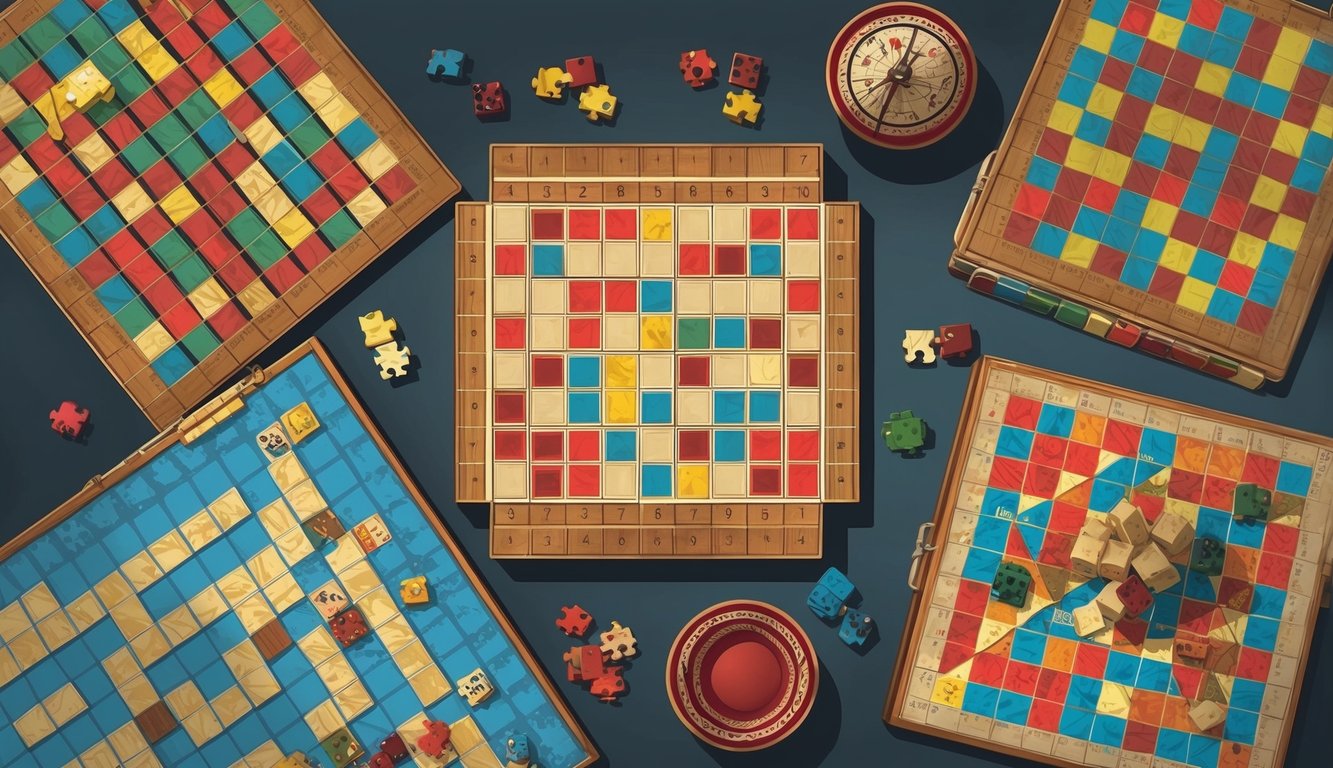
Logic puzzles come in many forms to challenge your mind.
You’ll find options ranging from number-based grids to word games and even immersive experiences.
Sudoku
Sudoku puzzles test your logical thinking with a 9×9 grid.
You fill each row, column, and 3×3 box with numbers 1-9, using deduction to place each digit correctly.
No guessing allowed!
Easier puzzles give you more starting numbers.
As you progress, fewer hints make the challenge greater.
You can find Sudoku in newspapers, puzzle books, and countless mobile apps.
Some variations mix things up.
Killer Sudoku adds math by grouping cells that must sum to a given total.
Jigsaw Sudoku replaces the standard 3×3 boxes with irregularly shaped regions.
Crosswords
Crosswords blend logic with language skills.
You solve clues to fill a grid of interlocking words.
Cryptic crosswords offer an extra layer of challenge with wordplay and hidden meanings in the clues.
American-style crosswords typically have a theme linking some answers.
British-style grids often have more black squares and fewer intersecting letters.
You’ll find crosswords of varying difficulty in newspapers and puzzle magazines.
Many solvers enjoy the social aspect of tackling crosswords with friends or in tournaments.
Nonograms
Also known as Picross or Griddlers, nonograms are picture logic puzzles.
You use number clues to fill in a grid, revealing a hidden image.
Each row and column has a set of numbers indicating groups of filled squares.
You deduce which cells to shade or leave blank based on these clues.
Nonograms range from small 5×5 grids to massive puzzles with hundreds of cells.
Colored nonograms add complexity by using multiple colors in the final image.
Many puzzle enthusiasts find nonograms addictive.
They offer a satisfying mix of logical reasoning and artistic revelation as the picture takes shape.
Escape Rooms
Escape rooms bring logic puzzles into the physical world.
You and your team are “locked” in a themed room, solving puzzles to find the way out before time runs out.
Puzzles might involve finding hidden objects, decoding messages, or manipulating physical mechanisms.
You’ll often need to combine clues from different parts of the room.
Many escape rooms tell a story as you progress.
Themes range from detective mysteries to sci-fi adventures.
Some even incorporate elements of haunted houses for added excitement.
Virtual escape rooms gained popularity during the pandemic.
These online versions let you solve similar puzzles from home, often with friends in different locations.
Creating Your Own Logic Puzzles
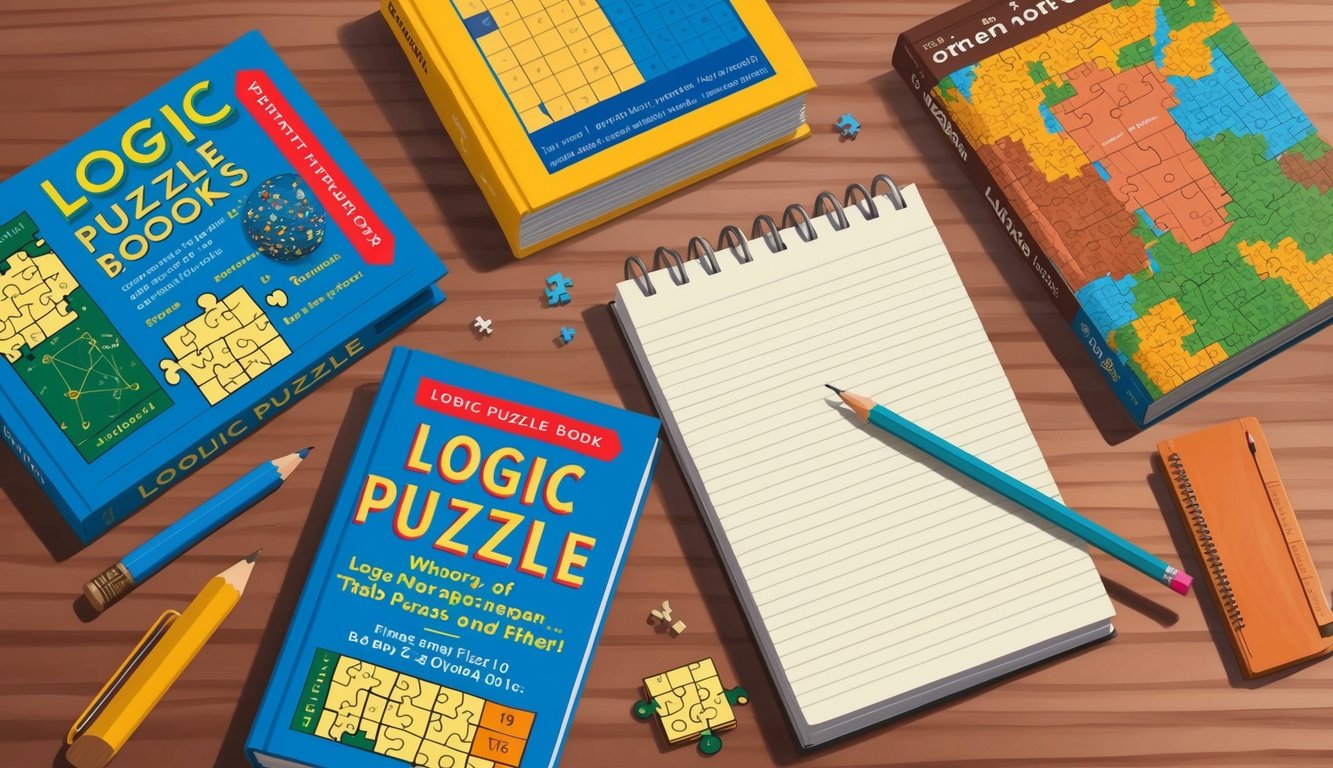
Designing logic puzzles can be a fun and rewarding challenge.
You’ll get to exercise your creativity while crafting mind-bending clues for others to solve.
Let’s explore the key steps to create your own logic puzzles.
Designing the Concept
Start by choosing a theme for your puzzle.
It could be about people’s hobbies, animals in a zoo, or even characters from your favorite book.
Decide how many variables you want to include – typically 3-5 work well for beginners.
Draw a grid with columns for each variable and rows for the possible options.
For example, if your puzzle is about 4 friends and their pets, you’d have columns for names and pet types.
Brainstorm interesting relationships between your variables.
Maybe Alex has a dog, but you don’t want to reveal that directly.
Think about indirect clues you can use instead.
Crafting Clues and Solutions
Now it’s time to write your clues.
Start with the solution in mind and work backwards.
Create a mix of positive and negative clues:
- “Alex’s pet isn’t a cat.”
- “The person with the fish lives next to the dog owner.”
Aim for about 8-12 clues for a medium-sized puzzle.
Make sure each piece of information is necessary to solve the puzzle – too many clues make it too easy!
Use clear, unambiguous language in your clues.
Avoid trick wording that could confuse solvers unfairly.
Testing and Iteration
Once you’ve written your clues, try solving the puzzle yourself.
Is it too easy? Too hard? Just right? Ask a friend to test it out and give feedback.
Look for ways to improve:
- Add or remove clues to adjust difficulty
- Reword confusing statements
- Ensure there’s only one correct solution
Don’t be afraid to revise and refine your puzzle multiple times.
The best logic puzzles often go through several iterations before they’re perfect.
Logic Puzzles for Kids
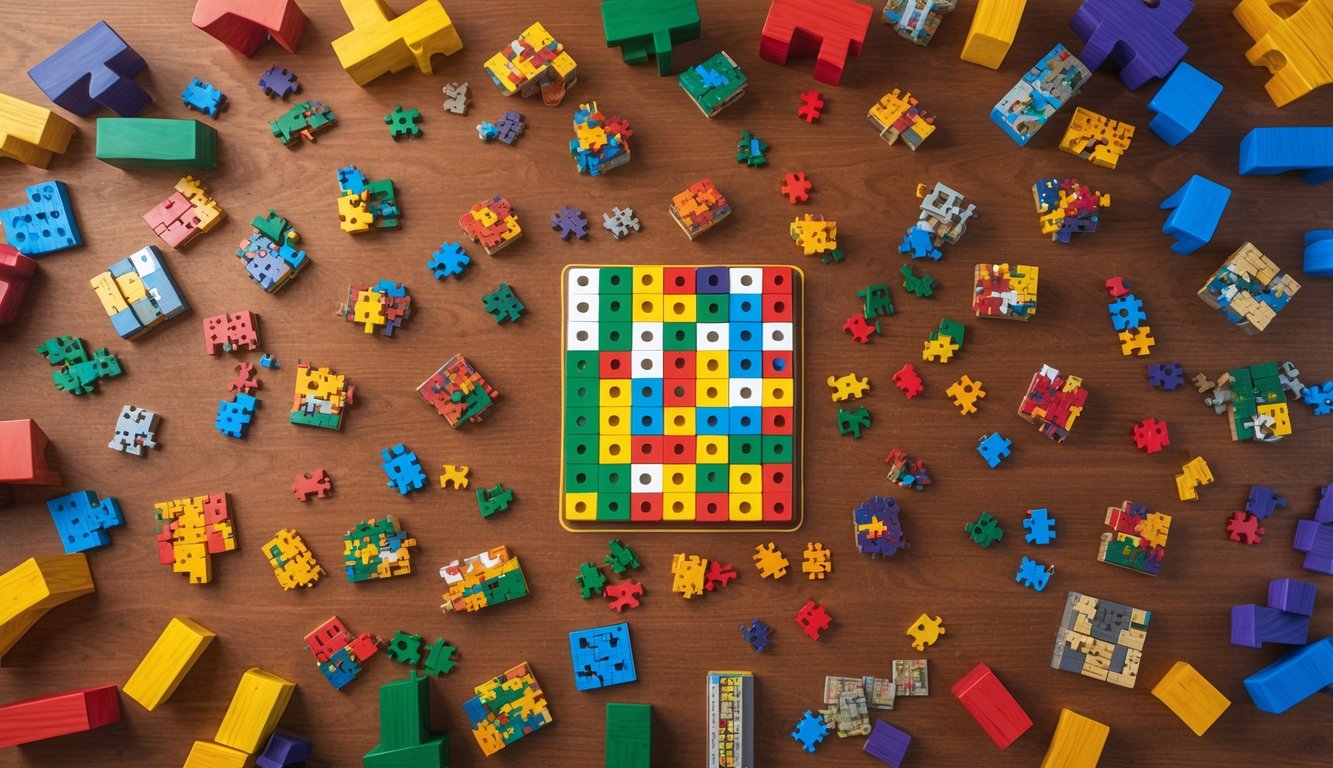
Logic puzzles offer children an engaging way to develop critical thinking skills while having fun.
These brain teasers come in various forms and difficulty levels, making them suitable for different age groups and learning styles.
Selecting Age-Appropriate Puzzles
When choosing logic puzzles for kids, consider their age and skill level.
For younger children, start with simple grid-based puzzles or those involving familiar objects like animals or toys.
As kids grow older, you can introduce more complex puzzles with multiple variables.
Try picture logic puzzles for visual learners.
These often feature colorful images or characters that appeal to children.
For number-loving kids, Sudoku-style puzzles can be a great fit.
Remember to gradually increase difficulty as children master easier puzzles.
Don’t forget about seasonal themes! Easter egg hunt puzzles can be a hit during spring, while island-hopping logic games might be perfect for summer.
Educational Benefits
Logic puzzles offer numerous educational advantages for children.
They enhance problem-solving abilities and improve deductive reasoning skills.
By working through these puzzles, kids learn to analyze information systematically and draw conclusions based on given clues.
These brain teasers also boost concentration and attention to detail.
As children solve puzzles, they practice patience and perseverance, valuable traits for academic success.
Logic puzzles can even support math skills by encouraging pattern recognition and strategic thinking.
Moreover, completing puzzles gives kids a sense of accomplishment, boosting their confidence and motivation to tackle new challenges.
This positive reinforcement can foster a love for learning that extends beyond puzzle-solving.
Fun Ways to Engage
Make puzzle time exciting by turning it into a family activity.
Challenge your kids to a puzzle-solving race or work together to crack a tricky brain teaser.
You can even create a puzzle scavenger hunt around your home or backyard.
Incorporate technology by using puzzle apps or online games.
Many websites offer free printable logic puzzles for kids, allowing you to mix up the types of puzzles you present.
Try different formats like grid puzzles, word problems, or visual riddles to keep things interesting.
Encourage creativity by letting your children design their own logic puzzles.
This activity not only reinforces problem-solving skills but also sparks imagination and critical thinking.
Don’t forget to praise their efforts and celebrate their puzzle-solving victories!
Themed Logic Puzzles
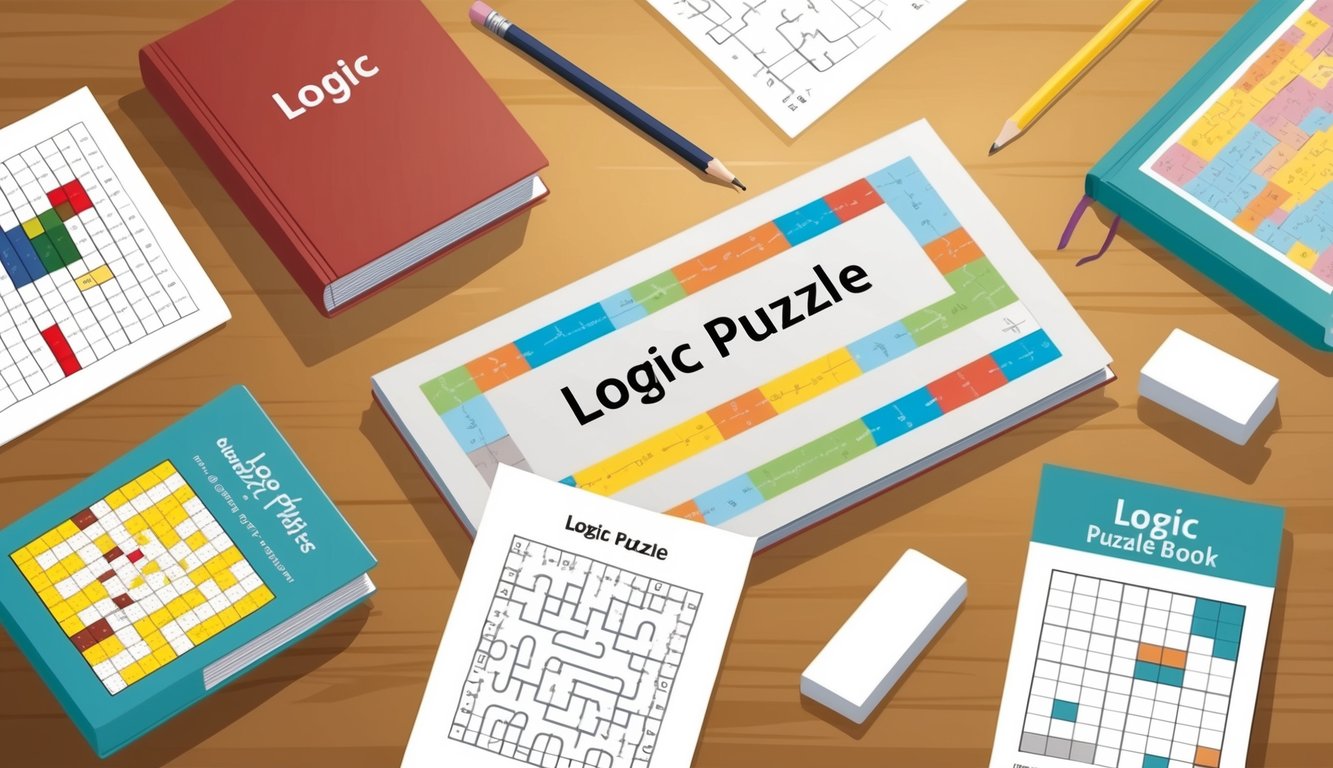
Logic puzzles come in all sorts of fun themes to spice up your problem-solving.
You’ll find special editions for holidays, historical events, and even fantasy worlds.
These themed puzzles add an extra layer of excitement to the classic logic grid format.
Holiday Specials
You’ll love tackling holiday-themed logic puzzles during festive seasons.
Valentine’s Day puzzles might have you matching couples with their date spots and gift choices.
Easter puzzles could challenge you to figure out which kids found which eggs in specific locations.
These seasonal brain teasers are perfect for getting into the holiday spirit.
They often feature cute graphics and themed clues that make solving even more enjoyable.
You can find holiday logic puzzles online or in special puzzle books released around major celebrations.
Historical Puzzles
Step back in time with historical logic puzzles.
You might solve mysteries involving famous figures or pivotal events.
Imagine unraveling clues about medieval knights and their quests, matching each knight to their armor, weapon, and mission.
These puzzles are a fun way to brush up on your history knowledge.
You’ll encounter interesting facts woven into the clues and categories.
Historical themes can range from ancient civilizations to more recent decades, giving you a wide variety of time periods to explore through puzzles.
Adventure and Fantasy
Embark on epic quests right from your puzzle book with adventure and fantasy-themed logic grids.
In these puzzles, you could sort out magical spells, mythical creatures, and brave heroes on daring missions.
These puzzles transport you to imaginative worlds filled with excitement.
You might decipher clues about dragon types, wizard abilities, or treasure locations.
Fantasy themes allow for creative category combinations that you won’t find in everyday logic puzzles.
Adventure puzzles often have you piecing together expedition details or solving mysteries in exotic locations.
They’re perfect for satisfying your wanderlust through problem-solving.

